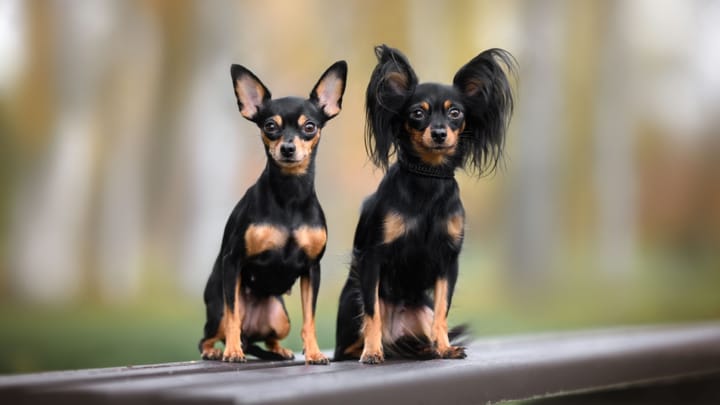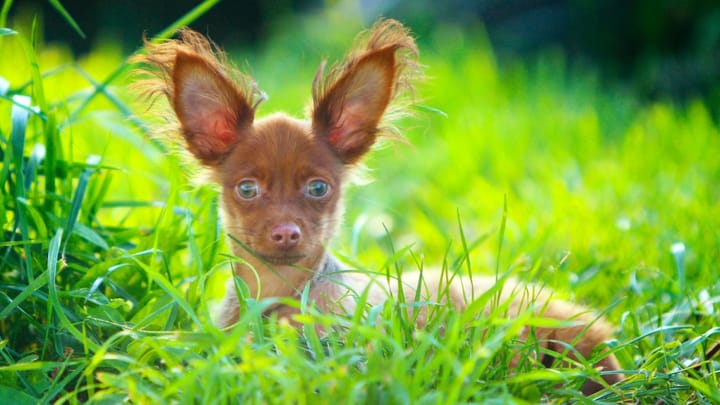Russian Toy
Other names : Russkiy Toy, Russian Toy Terrier


Energetic, bold, loyal and loving, the Russkiy Toy makes for the perfect companion dog, especially for those who live in small houses or flats.Originating from Russia, she was originally used to fight rats and so, is extremely alert and holds a fairly high prey drive. This pooch has fairly low exercise requirements and thrives on human company and attention - unfortunately, this makes her prone to separation anxiety.
|
Life expectancy |
The Russian Toy has a life expectancy of between 10 and 12 years |
|
Temperament |
|
|
Size |
Small
|
|
Adult size |
Female
Between 9 and 11 in
Male
Between 9 and 11 in
|
|
Adult weight |
Female
Between 4 and 7 lb
Male
Between 4 and 7 lb
|
|
Coat colour
Brown and tan, black and tan, lilac and tan, blue and tan, various shades of red, fawn, or cream. |
Black Brown Blue Red Sand |
|
Type of coat
Long or short: Smooth if short, wavy or straight if long. |
Short Long |
|
Eye colour
Dark. |
Brown
|
The Russkiy Toy has come extremely close to extinction - not once, but twice!
More details about the Russian Toy
Russian Toy: Origins and history
The adorable Russkiy Toy descends from the English Toy Terrier and was bred to hunt and kill rats. However, due to her charming personality and cute looks, she quickly became popular with Russian aristocrats as a companion dog. The population withered in the 1920s when Communism was on the rise, and almost became extinct during the fall of the Iron Curtain in 1989. Thankfully, though, the little trooper is still going strong today due to a rise in popularity in other countries.
Physical characteristics of the Russian Toy
The Russian Toy Terrier is a cute-looking small dog with a small head, tiny nose and pointed muzzle. She has large, wide-set eyes and adorable feathered, upright, large ears. In terms of the body, the Russkiy Toy has a straight back, lean, straight legs and an overall ‘elegant’ appearance. This is quite a fragile breed, even though the dog herself thinks she’s tough as nails!
FCI classification of the Russian Toy
-
Group 9 - Companion and Toy Dogs
-
Section 9 : Continental Toy Spaniel and Russian Toy
Russian Toy: Characteristics
Russian Toy: Behaviour
Training a Russian Toy
The Russian Toy Terrier falls somewhere in the middle when it comes to training. She picks up new tricks easily but can fall victim towards the classic ‘small dog syndrome’ if boundaries aren’t set early on. This breed hates harsh corrections and requires fun training sessions using plenty of positive reinforcement and rewards. To avoid seeing the willful, independent streak in this breed, make training consistent and extensive from an early age.
Russian Toy: Lifestyle
Breed compatibility Russian Toy
Russian Toy: Purchase price
Purchasing this breed will set you back a minimum of £650 for a Non-KC Registered dog. Looking after a dog of this size typically costs between £50 to £80 a month, including food, medical/insurance, and incidental expenses.
Russian Toy: Shedding
Average
Moderate shedder.
Russian Toy: Grooming
The Russkiy needs once or twice weekly brushing to minimize shedding, as well as an occasional bath (use gentle, hypoallergenic dog shampoo) if dirty. Overall, she’s a pretty low maintenance breed in terms of coat grooming. However, this breed is prone to dental diseases and requires daily tooth brushing. On top of this, the Russian’s nails are fast-growing and will need trimming regularly. Don’t forget to check those ears and give them a clean if necessary, too!
Russian Toy: Health
The Russkiy Toy is a resilient and healthy breed, but like most breeds, is prone to certain hereditary diseases. Their average lifespan is 11 years.
Despite her frail appearance, she is a sturdy and robust dog that rarely falls ill.
Plenty of water and a cool shelter must be offered during periods of extreme heat.
She needs to be protected from the cold.
She is not known to be particularly prone to weight gain. However, while owners sometimes adopt this breed due to her low exercise needs, it’s important to be aware she still needs walking for 30 minutes every day.
- Progressive retinal atrophy
- Bone fractures
- Patella luxation
- Legg-Calves-Perthes disease
- Dental issues
- Allergic reaction to certain medications
- Alveolitis




